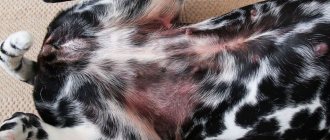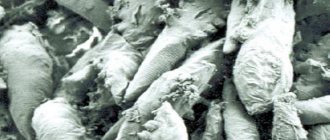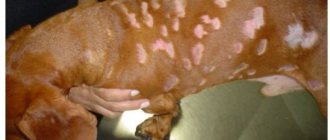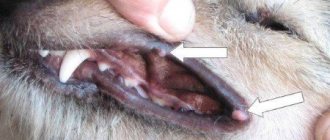What is dermatitis: nature of the disease and symptoms
Dermatitis is a disease that belongs to the category of allergic and can be caused by factors of various natures. In the general understanding, the principles of nosology are most often taken as the basis for classifying the nature of the disease. According to this doctrine, various disorders of the functioning of the body are united based on kinship. In this vein, dermatitis refers to skin diseases.
The main clinical picture is all kinds of skin lesions. Dermatitis is of infectious, inflammatory or hereditary origin. In this case, the course of the disease goes through two stages, and treatment is carried out taking this factor into account.
The acute phase is characterized by pronounced symptoms, which usually disappear if the animal is isolated from the source of the pathogen. The chronic stage occurs if the pet is constantly in contact with factors that cause irritation.
However, the symptoms of the disease at both stages are similar, although they have different degrees of manifestation. The presence of dermatitis can be diagnosed if the following skin changes are visually observed:
- Redness;
- Swelling of the affected area;
- Severe itching, burning;
- Hair loss;
- An increase in temperature at the site of inflammation, and throughout the body as a whole;
- Blisters, ulcers.
How does dermatitis manifest?
First of all, dermatitis manifests itself in the deterioration of the dog’s physical condition. Often this factor is supplemented by deviations in the behavior of the animal as a whole.
In the case of deterioration in physical condition, we are talking about visually observable changes - the affected areas become inflamed, red, covered with blisters and hematomas. In places of damage, hair often falls out and suppuration forms. Body temperature rises.
Characteristic violations of the behavioral aspect of animal functioning are:
- Obvious anxiety - the dog constantly scratches painful areas, aggravating the situation; moves from place to place;
- Changes in eating behavior - refusal to eat;
- Transformation of the animal’s character – reluctance to make contact with the owner or, conversely, aggressive reactions;
- Depression, apathy.
Factors provoking the development of dermatitis
Factors that cause the appearance and development of dermatitis can be divided according to their qualitative component. The nature of their occurrence may be:
- Physical;
- Biological;
- Chemical;
- Psychogenic character.
Physical factors
This group includes damage to the skin that occurred as a result of:
- Mechanical shock from an external object - stick, stone, sharp objects;
- Falls from a height;
- Exposure to high temperature (burn followed by dermatitis);
- Improper maintenance of the animal - lack of daylight or proximity to a source of electricity.
Biological factors
Biological causes of dermatitis represent the most common category of skin disease in dogs. Among the main pathogens:
- Pathogenic viruses (parvovirus, plague, hepatitis);
- Bacteria (streptococci, helminths);
- Some mushrooms and plants are poisonous if they enter the stomach of an animal.
Chemical factors
The list of chemicals that can lead to dermatitis is long. We are mainly talking about toxic aerosols, paints and varnishes, household chemicals and medicines.
Psychogenic factors
Stressful situations - a change of owner, place of residence or changes in feeding regimen - can lead to the appearance of dermatitis.
Differences from pododermatitis
Pododermatitis is a disease of an animal's paws. The clinical picture has some similarities with dermatitis: redness, sores, bloody boils and swelling. The causes, as in the case of dermatitis, can be mechanical (trauma), biological (viruses, infections) or allergic in origin (contact with a contaminated object, food intolerance to certain products).
The main difference from dermatitis is the fact that the disease affects the pads and paws of the animal. Failure to contact a veterinary clinic promptly can lead to lameness in your pet. Preventive measures consist of following hygiene procedures (washing paws after every walk, cleaning off dirt that accumulates between the animal’s toes, daily inspection of the pads).
Pododermatitis in a dog
It is also recommended to use hypoallergenic food (the main ones ]Eukanuba[/anchor], Purina Pro Plan, Royal Canin, Nutra Gold, Hills have a corresponding line). Often pododermatitis is a concomitant disease. In this case, relief of the animal’s condition directly depends on the successful fight against the underlying disease.
Treatment is with antibiotics. It is believed that certain breeds are more susceptible to this disease. These are Dachshunds, Labradors and German Shepherds.
Differences from dermatosis
In medical practice, it is believed that dermatosis is a general name for all skin diseases (Greek δέρμα is translated as “skin”). The list of causes is extensive and varied.
This includes deviations in the functioning of the nervous and endocrine systems, disturbances in the functioning of internal organs, immune problems, allergic reactions, inflammatory processes, and infections. Thus, dermatitis is one of the manifestations of dermatosis.
Causes of the disease
As a rule, the principles of nosology are taken as the basis for the classification of the nature of the disease: according to this doctrine, various disorders of the functioning of the body are combined according to the characteristics of kinship. In this vein, experts rightly classify dermatitis as a skin disease. Dermatitis can be infectious, inflammatory or hereditary in origin. Dermatitis can occur in all breeds of dogs, both adults and puppies. Stressful situations - unfavorable living conditions, change of owner, place of residence - can also lead to the appearance of dermatitis. Often the course of the disease is determined by several concomitant factors that must be taken into account when treating your pet. The lesion causes severe discomfort and causes changes in the dog’s behavior, leading to various complications. Identifying dermatitis in the early stages of its development will allow you to choose a treatment that will help suppress the developing disease in the shortest possible time. Treatment of dermatitis in dogs with modern methods of disease treatment and diagnosis in most cases has a positive prognosis. But this forecast will be justified if you consult a veterinarian in a timely manner.
Subscribe to the newsletter and get a discount at the pet store “Lubimchik”
Thanks for subscribing!
Classification of dermatitis in dogs
Considering the significant number of types of dermatitis in dogs, the most appropriate classification seems to be depending on the vector of influence of a particular factor. On this basis, dermatitis can be divided into two large groups - according to the causes of occurrence.
The first group of dermatitis is conventionally called exogenous. This means the appearance of dermatitis due to external causes. The main volume is due to mechanical dermatitis, including dermatitis resulting from exposure to high temperatures.
The second group consists of dermatitis, the cause of which is internal, endogenous factors. Most often, dogs are diagnosed with dermatitis from this group. Diseases of an endogenous nature are the following:
- Flea;
- Atopic;
- Acral;
- Malassezion;
- Allergic;
- Seborrhea.
Flea dermatitis
Flea dermatitis most often appears in the summer . According to statistics, more than 70% of allergic reactions in dogs are associated with the presence of fleas on the animal’s skin. There are currently almost 2,000 species of blood-sucking insects that can live in dog fur.
Flea dermatitis
The bulk is distributed evenly throughout the animal's body. But there are several rare types that settle either on the face or in the ears. Whatever the species of fleas, they operate on a similar principle. By digging into the skin of the animal, they suck out blood.
When a dog is bitten, insect saliva is introduced into the dog's body, which affects the rate of blood clotting. An allergic reaction occurs if the dog has a predisposition. Some researchers believe that breeds such as setters, spaniels and chow-chows are more susceptible to this type of irritation.
Clinical symptoms of flea dermatitis:
- Alopecia (complete hair loss);
- Hyperpigmentation (intense staining in the form of spots);
- Fibrous nodes, located mainly on the back, lower back, hips and abdomen.
Such manifestations are most often diagnosed in small breed dogs. In large dogs, symptoms of flea dermatitis may be completely absent. Diagnosis involves physically examining the animal and identifying the presence of fleas. A complete blood count is not usually performed.
In the early stages, in the absence of erosion, treatment consists of the use of special means - collars, drops and shampoos.
Atopic (allergic) dermatitis
Atopic dermatitis is considered the most insidious type of skin disease. The main clinical manifestations are itching, erosive areas, hair loss. Atopic dermatitis occurs against the background of an autoimmune failure under the influence of hereditary factors (genetic predisposition).
It is for this reason that diagnosis is extremely difficult and requires a comprehensive examination. Allergens can include dust, food, pollen, and other external irritants.
The disease manifests itself between the ages of 6 months and 3 years. In a veterinary clinic, microdoses of various allergens are applied to the animal’s skin and thus the source of the allergic reaction is determined. Treatment consists of long-term hormonal therapy and the use of antihistamines.
We recommend reading an article on the topic: “Symptoms and manifestations of allergies in dogs: we figure out what causes them and how to treat them.”
Atopic (allergic) dermatitis
Acral dermatitis
Acral dermatitis - plaques, the appearance of which is associated with the constant licking of individual areas of the paws by the animal. As a result, single ulcers are formed, which cause significant discomfort to the dog. The pet becomes restless and irritable; constantly licks the affected areas. This turns treatment into a complex process that requires considerable endurance, patience and perseverance from the owner.
Acral dermatitis is most often caused by infectious or bacterial pathogens. There is an opinion that stressful situations can serve as an impetus for the development of this disease. Animal psychologists adhere to this position. The best way to fight the disease can be considered special collars that make licking impossible. Additionally, anti-itching agents are used.
Acral dermatitis
Malassezia dermatitis
A special type of dermatitis that occurs as a result of a dog being infected with the fungus Malassezia pachydermatis . The main sign of infection in an animal is itching in the ear canal and groin area, as well as a very sharp, unpleasant odor from the dog.
It should be noted that yeast is present on the skin of many dogs, but the process of its transformation into a pathogenic factor is currently not well understood. Treatment is carried out using antifungal shampoos (sebozol, nizoral).
Malassezia dermatitis
Mechanical dermatitis
Mechanical dermatitis occurs as a result of external influences and is a consequence of injury. The latter can be obtained both on a walk and at home.
In the first case, this type of dermatitis is susceptible to:
- Service dogs that have long training sessions and significant workloads in their daily routine;
- Guard breeds kept in an enclosure;
- Free-ranging herding dogs.
The most common place of exposure to a traumatic factor is the animal’s paws. To avoid serious consequences, it is necessary to inspect your pet’s pads daily, as well as the area between the toes. If foreign objects (needles, splinters), wounds, cracks or cuts are found, it is necessary to treat the affected area with antiseptic drugs. A visit to the veterinarian is necessary if the presence of a foreign body is detected or redness is observed.
Mechanical dermatitis
In the second case, the appearance of mechanical dermatitis is possible in dogs of any breed living in an apartment. Household chemicals are a common source of skin disease. A simple preventative method is to keep cleaning products out of the animal's reach. An additional factor may be too high a room temperature. It is not recommended to set up a place for your pet near heating radiators.
Sun dermatitis
Sun dermatitis most often affects breeds with little or no hair - Chinese Crested, Mexican Hairless Dog, American Hairless Terrier, Dalmatian, Boxer, Beagle, Staffordshire Terrier. For these breeds, prolonged exposure to direct sunlight is the primary source of burns and subsequent dermatitis. It is necessary to reduce your pet's stay outside to a minimum on a hot summer day, from 11 a.m. to 2 p.m.
Dermatitis as a result of sunburn can develop in the nose and torso.
Damage to the skin of the nose is called nasal and is a common occurrence in dogs with wounds or cracks in the nasal area . This is due to the fact that the nose of animals is the most sensitive organ and is most susceptible to ultraviolet rays. Solar dermatitis of the trunk and extremities is less common. At the same time, the reasons for the occurrence are the same - prolonged exposure to sunlight.
Sun dermatitis
Seborrhea
Seborrhea is divided into primary and secondary.
It is believed that primary seborrhea is genetic in nature, while secondary seborrhea occurs as a result of metabolic disorders. Clinical symptoms are pronounced and similar for both types:
- Unpleasant, pungent odor from the animal;
- Dandruff;
- Itching;
- Dulling of fur.
Treatment is carried out using shampoos containing salicylic acid and tar.
Seborrhea
Prevention
The health of a pet largely depends on how the owners take care of it. The dog must be bathed regularly, and it is imperative to periodically take preventative antiparasitic medications. You should ensure that your pet’s skin does not come into contact with aggressive chemicals and that insects do not infest its fur. There is no need to resort to extremes in nutrition - the dog should receive those types of food that will provide it with energy and excellent functioning of all organs.
Dermatitis in dogs is an extremely unpleasant disease and the animal experiences a lot of discomfort from skin irritation. Having noticed the first signs of the disease, you need to immediately show your pupil to a qualified veterinarian, this will prevent all further changes in the skin.
Providing first aid to a dog
First aid for a dog with dermatitis consists of actions aimed at alleviating the animal’s general condition and reducing pain symptoms . The affected areas are treated with antiseptic drugs.
It is also recommended to remove fur if possible. Self-medication is not allowed, since any type of dermatitis can be a secondary disease. Further treatment is carried out according to the scheme prescribed by the veterinarian after examining the pet.
List of drugs against the disease
The list of drugs used in the treatment of dermatitis is extensive and depends on the specific diagnosis of the dog. Most often used:
| Drug name | Price | Mode of application |
| Prednisolone 5 mg, 100 tablets. | ~69 rub. | Anti-inflammatory, antiallergic agent. Dosage 1mg/1kg |
| Dexamethasone 5ml, drops | ~46 rub. | Antiallergic agent. The dosage is prescribed individually. |
| Cyclosporine, 50 mg | ~1200-4000 rub. | The active ingredient cyclosporine is the main medicine for Ecoral and Sandimmune. A powerful immunosuppressant. |
| Ceftriaxone 1 g, 50 bottle. | ~700 rub. | Antibiotic in powder form for solution preparation (intramuscular). The dosage is prescribed individually. |
Folk remedies to help
As first aid for a pet suffering from dermatitis, you can use folk remedies:
- Vegetables. The main assistant is potatoes, from which you can make compresses on painful places. Used in grated form with a gauze bandage.
- Fruits. Lotions made from a decoction of leaves are considered a good remedy. 200 gr. finely chopped leaves must be boiled for 5 minutes in 500 ml. water. Leave for 12 hours.
- Decoctions. Chamomile has an anti-inflammatory, soothing effect. Calendula has bactericidal properties and is used to disinfect wounds; in the form of an ointment, it is effective for cuts and erosions. Witch hazel reduces pain, relieves inflammation and swelling, and has antibacterial characteristics.
Dermatitis is a serious condition that can be caused by numerous factors. Self-diagnosis is difficult, and immediate contact with a specialist is necessary. The veterinarian will be able to determine the nature of the disease, prescribe appropriate treatment and help the pet.











